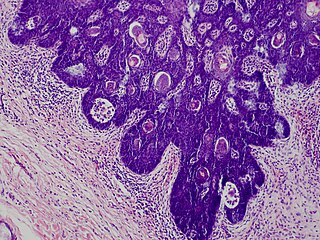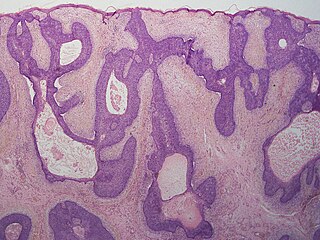
Nevus is a nonspecific medical term for a visible, circumscribed, chronic lesion of the skin or mucosa. The term originates from nævus, which is Latin for "birthmark"; however, a nevus can be either congenital or acquired. Common terms, including mole, birthmark, and beauty mark, are used to describe nevi, but these terms do not distinguish specific types of nevi from one another.

Dysplastic nevus syndrome, also known as familial atypical multiple mole–melanoma (FAMMM) syndrome, is an inherited cutaneous condition described in certain families, and characterized by unusual nevi and multiple inherited melanomas. First described in 1820, the condition is inherited in an autosomal dominant pattern, and caused by mutations in the CDKN2A gene. In addition to melanoma, individuals with the condition are at increased risk for pancreatic cancer.

The congenital melanocytic nevus is a type of melanocytic nevus found in infants at birth. This type of birthmark occurs in an estimated 1% of infants worldwide; it is located in the area of the head and neck 15% of the time.

A blue nevus is a type of coloured mole, typically a single well-defined blue-black bump.
Congenital smooth muscle hamartoma is typically a skin colored or lightly pigmented patch or plaque with hypertrichosis. Congenital smooth muscle hamartoma was originally reported in 1969 by Sourreil et al.

Nevus lipomatosus superficialis is characterized by soft, yellowish papules or cerebriform plaques, usually of the buttock or thigh, less often of the ear or scalp, with a wrinkled rather than warty surface. It is usually congenital in origin or appears within the first three decades.
Targetoid hemosiderotic hemangioma, also known as a hobnail hemangioma is a skin condition characterized by a central brown or purplish papule that is surrounded by an ecchymotic halo. It may appear similar to melanoma. It was first described by Santa Cruz and Aronberg in 1988.
Glomeruloid hemangioma is a distinctive vascular tumor first described in 1990 when found to be associated with POEMS syndrome and Castleman disease. Glomeruloid hemangiomas can manifest as wine-red sessile or pedunculated papules, papulonodules, subcutaneous bluish compressible tumors, or small, firm, reddish-violaceous, dome-shaped papules.
Neural fibrolipoma is an overgrowth of fibro-fatty tissue along a nerve trunk that often leads to nerve compression. These only occur in the extremities, and often affect the median nerve. They are rare, very slow-growing, and their origin is unknown. It is believed that they may begin growth in response to trauma. They are not encapsulated by any sort of covering or sheath around the growth itself, as opposed to other cysts beneath the skin that often are. This means there are loosely defined margins of this lipoma. Despite this, they are known to be benign. Neural fibrolipomas are often more firm and tough to the touch than other lipomas. They are slightly mobile under the skin, and compress with pressure.
Chondroid lipomas are deep-seated, firm, yellow tumors that characteristically occur on the legs of women. They exhibit a characteristic genetic translocation t(11;16) with a resulting C11orf95-MKL2 fusion oncogene.

Folliculosebaceous cystic hamartoma abbreviated as (FSCH) is a rare cutaneous hamartoma consisting of dilated folliculosebaceous units invested in mesenchymal elements. it typically affects adults, have a predilection for the central face or scalp, with less than 1.5 cm dimension. Clinically, the lesions are asymptomatic, rubbery to firm in consistency, and usually occur on or above the neck in of cases, Histopathologically, FSCH shares several similar features to sebaceous trichofolliculoma, but it is usually possible to differentiate these two tumors.
An eccrine nevus is an extremely rare cutaneous condition that, histologically, is characterized by an increase in size or number of eccrine secretory coils. Hyperhidrosis is the most common symptom. It can present as discoloured nodules, papules, or plaques. Eccrine nevus mostly affects the extremities. Eccrine nevus are diagnosed based of histology. Treatment includes surgical excision or topical medications.

Balloon cell nevus is a benign nevus. It appears like a melanocytic nevus.

Basaloid follicular hamartoma is a cutaneous condition characterized as distinctive benign adnexal tumor that has several described variants. It manifest as small tan or brown coloured papules in the trunk, pubic area, face, scalp, and axilla.
A superficial acral fibromyxoma is a type of myxoma and is a rare cutaneous condition characterized by a mesenchymal neoplasm that typically occurs on the digits of middle-aged adults.
Rheumatoid neutrophilic dermatitis, also known as rheumatoid neutrophilic dermatosis, is a cutaneous condition associated with rheumatoid arthritis.
Porokeratotic eccrine ostial and dermal duct nevus (PEODDN) is a skin lesion that resembles a comedonal nevus, but it occurs on the palms and soles where pilosebaceous follicles are normally absent. It is probably transmitted by paradominant transmission.
Mucinous nevus is a rare cutaneous condition characterized by hamartoma that can be congenital or acquired. Mucinous nevus presents as multiple skin-coloured or brown asymptomatic papules or plaques. Mucinous nevus is diagnosed based of histological features. Treatment is not needed.
Tegumental angiomyxoma-neurothekeoma is a syndrome, an acronym, and eponym proposed by Malaysian ophthalmologist of Chinese Descent, Tan Aik Kah. Angiomyxomas are associated with LAMB syndrome, NAME syndrome and Carney syndrome.








